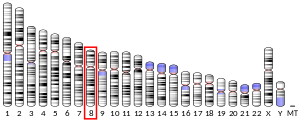RRM2B
RRM2B (リボヌクレオシド二リン酸レダクターゼ サブユニットM2 B、英:Ribonucleoside-diphosphate reductase subunit M2 B) はヒトのRRM2B 遺伝子がコードしている酵素である[5][6][7][8]。RRM2Bタンパク質をコードしている遺伝子は8番染色体、8q23.1に位置している。この遺伝子および遺伝子産物は別名MTDPS8A、MTDPS8B、p53R2でも知られている。
機能
[編集]リボヌクレオシド二リン酸レダクターゼはリボヌクレオシド二リン酸を還元してデオキリボヌクレオシド二リン酸に変換することで、DNA複製に必要なヌクレオチド前駆体を産生する酵素であり、RRM2B 遺伝子はこのリボヌクレオチドレダクターゼの2種類あるR2サブユニットの内の片方をコードしている。RRM2B 遺伝子がコードしている方のR2サブユニットはp53によって誘導され、増殖してない細胞における正常なDNA修復とミトコンドリアDNA合成に必須である。R2サブユニットのもう1種類は分裂細胞でのみ発現する[9]。
相互作用
[編集]RRM2BはMdm2[10]およびATM[10]とタンパク質間相互作用を示す[10]。
臨床との関係
[編集]この遺伝子の異常はミトコンドリアDNA枯渇症候群 (MDDS)の原因の1つである[11][12]。この遺伝子の変異は新生児の筋緊張低下、成長の遅れ、脳症と関連しており、てんかんの発作、難聴、乳酸アシドーシスを伴う。この症候群は致死的であり、幼年期早期に呼吸不全を起こして死亡する[13][14]。
この遺伝子はまた小児急性肝不全のいくつかの症例とも関連していた[15]。この遺伝子の変異は進行性の外眼筋麻痺を引き起こすことが示されている[16]。RRM2Bの発現増加は胆管癌細胞においてゲムシタビン耐性とも関連しており[17]、ヒトのがんにおいてゲムシタビンの臨床的利益がえられないかもしれないと予測されている。
脚注
[編集]- ^ a b c GRCh38: Ensembl release 89: ENSG00000048392 - Ensembl, May 2017
- ^ a b c GRCm38: Ensembl release 89: ENSMUSG00000022292 - Ensembl, May 2017
- ^ Human PubMed Reference:
- ^ Mouse PubMed Reference:
- ^ “A ribonucleotide reductase gene involved in a p53-dependent cell-cycle checkpoint for DNA damage”. Nature 404 (6773): 42–9. (March 2000). doi:10.1038/35003506. PMID 10716435.
- ^ “A ribonucleotide reductase gene is a transcriptional target of p53 and p73”. Oncogene 19 (37): 4283–9. (August 2000). doi:10.1038/sj.onc.1203774. PMID 10980602.
- ^ “Mutation of RRM2B, encoding p53-controlled ribonucleotide reductase (p53R2), causes severe mitochondrial DNA depletion”. Nature Genetics 39 (6): 776–80. (June 2007). doi:10.1038/ng2040. PMID 17486094.
- ^ “Entrez Gene: RRM2B ribonucleotide reductase M2 B (TP53 inducible)”. 2017年8月1日閲覧。
- ^ “Defects in mitochondrial DNA replication and human disease”. Critical Reviews in Biochemistry and Molecular Biology 47 (1): 64–74. (2012). doi:10.3109/10409238.2011.632763. PMC 3244805. PMID 22176657.
- ^ a b c “ATM-mediated serine 72 phosphorylation stabilizes ribonucleotide reductase small subunit p53R2 protein against MDM2 to DNA damage”. Proceedings of the National Academy of Sciences of the United States of America 105 (47): 18519–24. (November 2008). doi:10.1073/pnas.0803313105. PMC 2587585. PMID 19015526.
- ^ Gorman, Gráinne S.; Taylor, Robert W. (April 17, 2014). “RRM2B-Related Mitochondrial Disease”. GeneReviews. University of Washington, Seattle
- ^ “RRM2B-related mitochondrial DNA depletion syndrome, encephalomyopathic form with renal tubulopathy”. United States National Library of Medicine. 13 July 2017閲覧。
- ^ “A novel mutation of the RRM2B gene in an infant with early fatal encephalomyopathy, central hypomyelination, and tubulopathy”. Molecular Genetics and Metabolism 98 (3): 300–4. (November 2009). doi:10.1016/j.ymgme.2009.06.012. PMID 19616983.
- ^ “Novel RRM2B Mutation and Severe Mitochondrial DNA Depletion: Report of 2 Cases and Review of the Literature”. Neuropediatrics. (May 2017). doi:10.1055/s-0037-1601867. PMID 28482374.
- ^ “Deep Sequencing Reveals Novel Genetic Variants in Children with Acute Liver Failure and Tissue Evidence of Impaired Energy Metabolism”. PloS One 11 (8): e0156738. (2016). doi:10.1371/journal.pone.0156738. PMID 27483465.
- ^ “Exome sequencing identifies a novel missense variant in RRM2B associated with autosomal recessive progressive external ophthalmoplegia”. Genome Biology 12 (9): R92. (September 2011). doi:10.1186/gb-2011-12-9-r92. PMC 3308055. PMID 21951382.
- ^ “Gene expression analysis for predicting gemcitabine resistance in human cholangiocarcinoma”. Journal of Hepato-Biliary-Pancreatic Sciences 18 (5): 700–11. (September 2011). doi:10.1007/s00534-011-0376-7. PMID 21451941.
参考文献
[編集]- “Mammalian p53R2 protein forms an active ribonucleotide reductase in vitro with the R1 protein, which is expressed both in resting cells in response to DNA damage and in proliferating cells”. The Journal of Biological Chemistry 276 (44): 40647–51. (November 2001). doi:10.1074/jbc.M106088200. PMID 11517226.
- “p53R2-dependent pathway for DNA synthesis in a p53-regulated cell cycle checkpoint”. Cancer Research 61 (22): 8256–62. (November 2001). PMID 11719458.
- “Expression of p53R2, newly p53 target in oral normal epithelium, epithelial dysplasia and squamous cell carcinoma”. Cancer Letters 190 (2): 233–43. (February 2003). doi:10.1016/S0304-3835(02)00588-8. PMID 12565178.
- “Wild-type p53 regulates human ribonucleotide reductase by protein-protein interaction with p53R2 as well as hRRM2 subunits”. Cancer Research 63 (5): 980–6. (March 2003). PMID 12615712.
- “The human ribonucleotide reductase subunit hRRM2 complements p53R2 in response to UV-induced DNA repair in cells with mutant p53”. Cancer Research 63 (20): 6583–94. (October 2003). PMID 14583450.
- “In vitro characterization of enzymatic properties and inhibition of the p53R2 subunit of human ribonucleotide reductase”. Cancer Research 64 (1): 1–6. (January 2004). doi:10.1158/0008-5472.CAN-03-3048. PMID 14729598.
- “Inhibitory effect of c-Myc on p53-induced apoptosis in leukemia cells. Microarray analysis reveals defective induction of p53 target genes and upregulation of chaperone genes”. Oncogene 24 (28): 4559–71. (June 2005). doi:10.1038/sj.onc.1208652. PMID 15856024.
- “Novel genetic variations of the p53R2 gene in patients with colorectal adenoma and controls”. World Journal of Gastroenterology 11 (33): 5169–73. (September 2005). PMID 16127747.
- “Genotoxicity test system based on p53R2 gene expression in human cells: examination with 80 chemicals”. Mutation Research 588 (1): 47–57. (December 2005). doi:10.1016/j.mrgentox.2005.09.002. PMID 16236544.
- “Characterization of enzymatic properties of human ribonucleotide reductase holoenzyme reconstituted in vitro from hRRM1, hRRM2, and p53R2 subunits”. Biochemical and Biophysical Research Communications 340 (2): 428–34. (February 2006). doi:10.1016/j.bbrc.2005.12.019. PMID 16376858.
- “Expression of p53R2 is related to prognosis in patients with esophageal squamous cell carcinoma”. Clinical Cancer Research 12 (12): 3740–5. (June 2006). doi:10.1158/1078-0432.CCR-05-2416. PMID 16778101.
- “Enzymatic property analysis of p53R2 subunit of human ribonucleotide reductase”. Advances in Enzyme Regulation 46: 235–47. (2007). doi:10.1016/j.advenzreg.2006.01.016. PMID 16846634.
- “Effect of high-risk human papillomavirus oncoproteins on p53R2 gene expression after DNA damage”. Virus Research 122 (1-2): 189–93. (December 2006). doi:10.1016/j.virusres.2006.06.011. PMID 16872707.
- “Improvement in radiosensitivity using small interfering RNA targeting p53R2 in esophageal squamous cell carcinoma”. Oncology Reports 18 (3): 561–7. (September 2007). doi:10.3892/or.18.3.561. PMID 17671702.





